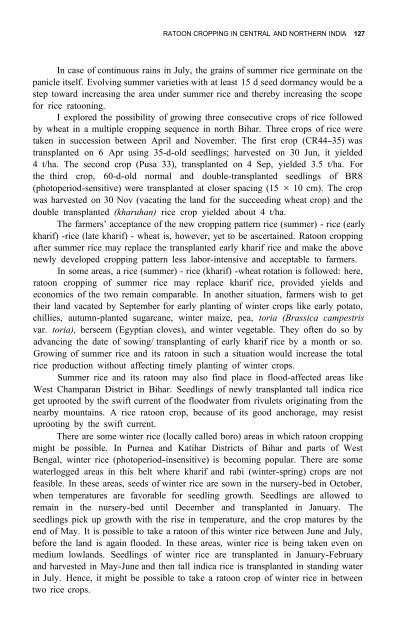RICE RATOONING - IRRI books - International Rice Research Institute
RICE RATOONING - IRRI books - International Rice Research Institute
RICE RATOONING - IRRI books - International Rice Research Institute
You also want an ePaper? Increase the reach of your titles
YUMPU automatically turns print PDFs into web optimized ePapers that Google loves.
RATOON CROPPING IN CENTRAL AND NORTHERN INDIA 127In case of continuous rains in July, the grains of summer rice germinate on thepanicle itself. Evolving summer varieties with at least 15 d seed dormancy would be astep toward increasing the area under summer rice and thereby increasing the scopefor rice ratooning.I explored the possibility of growing three consecutive crops of rice followedby wheat in a multiple cropping sequence in north Bihar. Three crops of rice weretaken in succession between April and November. The first crop (CR44-35) wastransplanted on 6 Apr using 35-d-old seedlings; harvested on 30 Jun, it yielded4 t/ha. The second crop (Pusa 33), transplanted on 4 Sep, yielded 3.5 t/ha. Forthe third crop, 60-d-old normal and double-transplanted seedlings of BR8(photoperiod-sensitive) were transplanted at closer spacing (15 × 10 cm). The cropwas harvested on 30 Nov (vacating the land for the succeeding wheat crop) and thedouble transplanted (kharuhan) rice crop yielded about 4 t/ha.The farmers’ acceptance of the new cropping pattern rice (summer) - rice (earlykharif) -rice (late kharif) - wheat is, however, yet to be ascertained. Ratoon croppingafter summer rice may replace the transplanted early kharif rice and make the abovenewly developed cropping pattern less labor-intensive and acceptable to farmers.In some areas, a rice (summer) - rice (kharif) -wheat rotation is followed: here,ratoon cropping of summer rice may replace kharif rice, provided yields andeconomics of the two remain comparable. In another situation, farmers wish to gettheir land vacated by September for early planting of winter crops like early potato,chillies, autumn-planted sugarcane, winter maize, pea, toria (Brassica campestrisvar. toria), berseem (Egyptian cloves), and winter vegetable. They often do so byadvancing the date of sowing/ transplanting of early kharif rice by a month or so.Growing of summer rice and its ratoon in such a situation would increase the totalrice production without affecting timely planting of winter crops.Summer rice and its ratoon may also find place in flood-affected areas likeWest Champaran District in Bihar. Seedlings of newly transplanted tall indica riceget uprooted by the swift current of the floodwater from rivulets originating from thenearby mountains. A rice ratoon crop, because of its good anchorage, may resistuprooting by the swift current.There are some winter rice (locally called boro) areas in which ratoon croppingmight be possible. In Purnea and Katihar Districts of Bihar and parts of WestBengal, winter rice (photoperiod-insensitive) is becoming popular. There are somewaterlogged areas in this belt where kharif and rabi (winter-spring) crops are notfeasible. In these areas, seeds of winter rice are sown in the nursery-bed in October,when temperatures are favorable for seedling growth. Seedlings are allowed toremain in the nursery-bed until December and transplanted in January. Theseedlings pick up growth with the rise in temperature, and the crop matures by theend of May. It is possible to take a ratoon of this winter rice between June and July,before the land is again flooded. In these areas, winter rice is being taken even onmedium lowlands. Seedlings of winter rice are transplanted in January-Februaryand harvested in May-June and then tall indica rice is transplanted in standing waterin July. Hence, it might be possible to take a ratoon crop of winter rice in betweentwo rice crops.

















